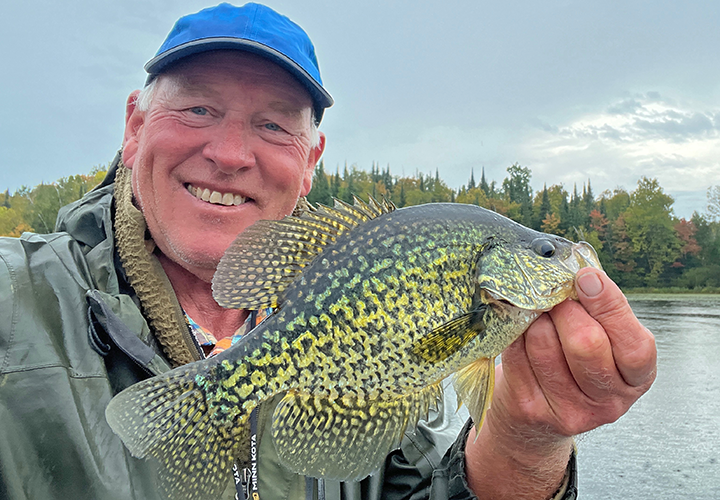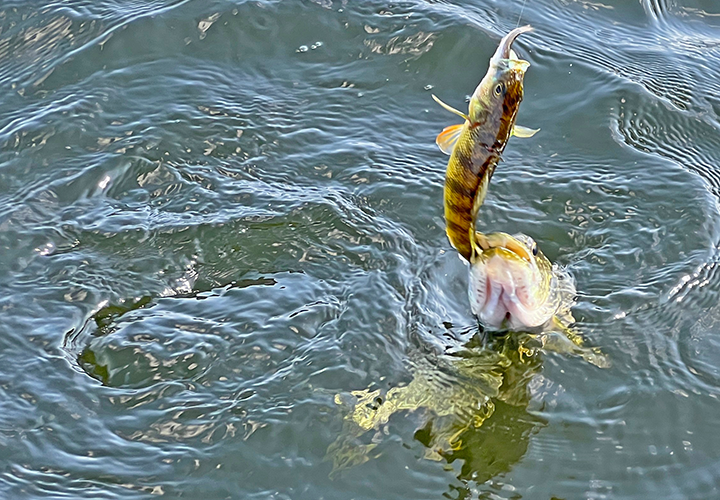Transitioning into fall fishing patterns, both Lake Winnie and Cutfoot Sioux are providing a wide range of opportunities for anglers. Walleye action is improving, crappies have showed up to the party now too and so have yellow perch. Sunfish, northern pike and bass have been active all summer, and all of them continue to provide great fishing action.
Water temperatures cool, walleye action heats up!
Winnie’s water conditions have been clearer this season than they were last year and as water temperatures cool, clarity is increasing even more. Because walleye feeding patterns are heavily influenced by water conditions, there are times when the fishing seems slow compared to the 2022 season but not because the fish aren’t there. Picking your days, your fishing times and adjusting to changes in weather and lighting conditions is the key to making the action in 2023 feel the same as it did in 2022.
Water temperatures dropped to the mid-60s about a week ago and then stabilized. Today, you’ll find temperatures on the big lake that range between 63 and 66 degrees; in Cutfoot, slightly warmer. In shallow water and protected back bays, vegetation has begun dying off, forcing some baitfish into areas where the grass is greener. Others have taken up residence in open areas over slightly deeper water, but not into the lake’s deepest mid-section.
For walleyes, located on the edges of cabbage, coontail or mixed vegetation, summer trolling patterns can still provide action. Spinners tipped with minnows, or night crawlers are especially good during low-light periods at dusk or sunrise. On calmer days, or when conditions turn bright, moving out onto the flats will produce action too. Our guide, Jared Saufferer trolled spinners in 14 to 15 feet of water and showed some of our guests a very rewarding first ever walleye trip. For Jared, the north side of Winnie, everywhere from the gap, west to Mallard Point have produced reliable results.
When the wind blows, especially on cloudy days, drifting the shallow breaklines, or on shallow rocky structure using jig and minnow combinations are more efficient. Walleyes are responding to jigs better every day, and on the big lake, perch and pike are showing up in the mix too. Key depths are 6 to 8 feet along shoreline breaks. On structure, like rocks, walleyes and yellow perch may move even shallower, one report last week had anglers catching fish in 3 feet of water. “We did have a strong wind, and the sky was dark, and that made the fish active”, our friend told us.
Periods of calm, especially when the sky is bright, do not favor shallow water walleye presentations of any kind. If you’re determined to fish walleyes during the daytime, positioning the boat and casting toward fish will be your best option. Slip floats, using ½ night crawlers or lively minnows are a good choice.
Jigging lures are an important alternative too, and soft plastics should be tested too. As we are sure you’ve heard, advanced electronics make this type of fishing easier. Veteran anglers, who know the lakes well, can also use this technique by positioning within casting distance of known structures. Either way, the trick is to cast, presenting fish an opportunity to strike, before realizing the presence of your boat.
After dark, trolling crankbaits is an option, and is popular in some circles. Shoreline breaks and mid-depth flats are key locations, and best fishing depths range from 8 to 16 feet, depending on the structures.
Crappies are on the move and active in both, shallow or deep water.
Crappies were hard to come by for most of the summer, but today, reports are much better. Cooling water temperatures encouraged a move out of the shallow vegetation and into open water. Anglers found them quickly, a began catching them using trolling presentations. Spinners tipped with minnows are good, so are jigs tipped with soft, action tail type plastics. Paddle tails, twirl tails and spin jigs are all producing good results.
Last week, on their annual fishing trip with Jeff Sundin, the VA Nurses spent one day fishing for panfish. Trolling spinners tipped with minnows; they caught lots of crappies in water depths of 12 to 14 feet. The fish were located outside the grass line, in open water, but remained close to the shore.
In his own report, Sundin wrote, “I can’t say which day will be the one when they disappear, but I can tell you why they will do it. They will make a move back into the weeds.” It might be worth your time to review that report, September 8, 2023, for yourself. But the main point was that, during the transition into fall, crappies will move in and out between shoreline vegetation and open water for a time.
Another interesting twist from the VA Nurses was that trolling spinners tipped with minnows produced crappies. One simple change instantly turned their lures into a sunfish presentation. Take off the minnow, put on a night crawler instead and you’ll find sunfish are using the same, or nearby areas too. The spinner and night crawler combination is also likely to produce some crappies too, so try this if you’re thinking that a mix of the two species might be nice.
If you check the open water, find no panfish, and wonder where to look next, check the grass. Cast small, 1/16-ounce jigs tipped with plastics toward the shoreline, and retrieve using a fall-swim-fall-swim retrieve. The small jigs fall slowly so allow plenty of drop time between swimming them toward the boat.
Yellow perch, another fish that seemed harder to come by during the summer are also showing up in better numbers, and there are fish of good quality size being caught. Some folks are catching them in Big Cutfoot, others are catching them on the big lake. No matter where they’re found, spinners tipped with minnows, along with jigs and minnows are the 2 main presentations being used.
Yellow Perch have become active, obviously, so are Northern Pike!
The best fishing occurs on cloudy, breezy days and the key locations are shallow. Vegetation on the shoreline in 6 to 8 feet of water, shallow rocks in 4 to 8 feet of water, and the outside edges of deeper vegetation in 12 to 14 feet are productive locations. Right now, perch are scattered, inhabiting long stretches of shoreline in small packs, rather than concentrated in small spots. By all accounts, perch are feeding on minnows, primarily young of the year perch, so they tend to be nomadic. If your goal is to catch perch in good numbers, cover territory using the spinners and once located, switch to jigs and minnows to enhance efficiency.
Northern pike are not being targeted by most folks, but as you can see, are also active and either way, they are being caught!
Trolling spinners or crankbaits, using jigs and minnows, or casting soft plastics are all producing bonus pike. The special regulations on harvesting northern pike are apparently having a positive impact on pike in Winnie. It’s still early in the process, but we do see and hear about folks catching lots of fish in the protected, 22-to-26-inch size range. There are not a lot, but fish in the 26-to-28-inch range are becoming more common these days too.
Casting larger bucktails, spoons or spinnerbaits are all productive, but not in the obvious locations. Rocks will produce more pike than grass right now. The depth of the rocks seems less important than the presence of them, so check any rocky area, whether it is shallow or deep. Steep breaklines are an alternative for pike, use live bait rigs, larger hooks, or quick strike rigs and tip them with sucker minnows in the 6-to-10-inch size range. Troll or drift the steepest breaklines on the lake’s larger, mid-lake bars. The Bena Bar, and steep shoreline breaks on the east side of the big lake are noted for being good areas for this type of fishing.
Fall colors setting in, cooler water and active fish; it’s a great time to be on the lake!
Fall is a time we look forward to, and for lots of reasons. But as anglers, we appreciate the energy that comes along with the intensity of feeding behavior that comes with cooling water. We’re watching the progressions, and will share the details as fall progresses. Stay Tuned!






